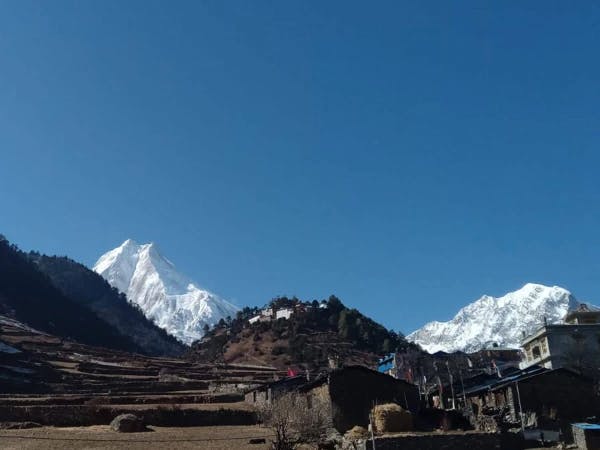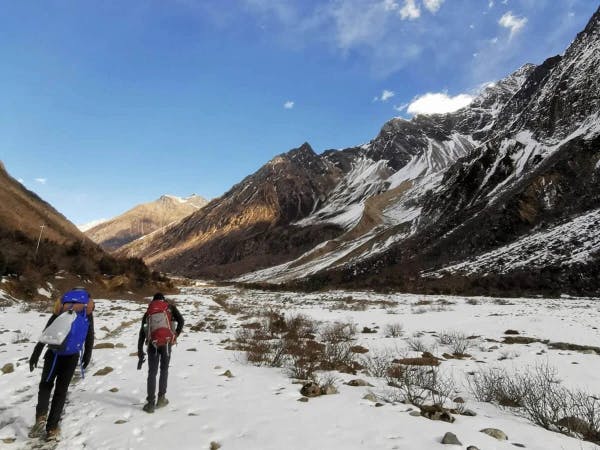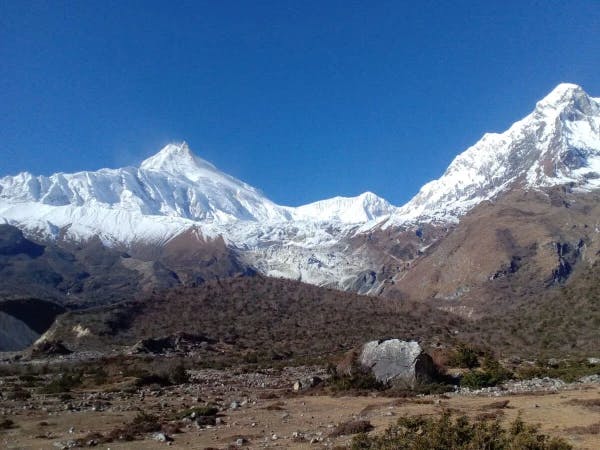Bishal, my guide, was brilliant. Extensive knowledge of the area and terrain, was great company and looked after me well.
One of the best classic Tsum Valley Treks is to the northern Gorkha, bordered by some of the massive majestic giants of Nepal, i.e., Boudha and Chuli Himal to the west, Sringi Himal to the north, and Ganesh Himal to the south, under the Manaslu Restricted Area of the country.
The history of the valley takes you to century-old ancient Vajrayana Buddhism and Bon, passing by major two villages noted for their unique culture and traditions reflecting the influence of the Tibetan lifestyle, Chumling (Lower Tsum) and Chaikampar (Upper Tsum).
The Gumba Lungdang, Pungen Gumpa, Rachen Gompa, and Mu Gompa are some of the most notable religious and historical landmarks of the Tsum Valley, where many spiritual leaders and gurus are believed to have mediated, which has come together to create one of the sacred valleys for Buddhism and Hinduism, still hidden and untouched by the increasing speed of modernity.
The Tsumbas are the natives of the Tsum Valley, with the thundering, deep-throated sound of the Tibtean horn showcasing their unique art of living as portrayed by several monasteries in the region performing their day-to-day rituals and offering offerings seeking liberation.
Similarly, the whole Tsum Valley region is also a spectacular creation of mother nature, beautified with a patchwork of alpine meadows, terraced farms, and a wide population of lively fauna playing in the foothills of Ganesh Himal.
Hence, the Tsum Valley adventure is the most pleasant and outstanding diversified cultural and natural exploration watched over by some of the major sky-dominating peaks of Nepal, including Ganesh, Shringi, and Boudha Himal.
Highlights
- Enjoy the scenic drive from Kathmandu to Soti Khola.
- Explore the secret valleys and the diverse culture of the Manalsu region.
- Venture into the intriguing off-beaten, remote trekking trails of the restricted region of Nepal.
- Observe the distinctive customary life of Tsumbas and others, which bears a closer resemblance to Tibet.
- Embrace the pristine and serene nature of the eighth-tallest mountain in the world, Mt. Manaslu (8,163 m or 26,781ft).
- Discover the wide array of Himalayan flora and fauna.
- Uphold the extensive mountain views of Mt. Manaslu (8,163 m/26,781 ft), Machapuchare (6,993 m/22,943 ft), Gangapurna (7,455 m/24,459 ft), Annapurna I (8,091 m/26,545 ft) and its ranges, Ganesh Himal (7,422 m/24,350 ft), and others from Ganesh Himal Base Camp (4200 m/13,780 ft) and throughout the trekking trail.
- Vibrant typical valleys, monasteries, Mani walls, and gompas adorned with prayer flags
- Hike through the lush forests of pine, juniper, and rhododendron, along with cascading waterfalls, roaring rivers, and caves, with the possibility of encountering very rare blue sheep and Himalayan tahr.
What to expect at this Tsum Valley Trek?
The valley that did not see any visitors until 2008, Tsum, is still one of the restricted zones of Nepal, which allows travelers and trekkers only when permitted by different special cards regulated by the government of Nepal and local authorities themselves.
Therefore, the land of Tsum retains the most authentic culture, nature, and bounty of others yet to be discovered, hidden in the north Himalayan rain shadow area of the country. A trek here is one must-do where you can expect:
The unique cultural encounter
The trekking route to the Tsum passes through several typical village areas, mostly inhabited by the indigenous communities of Gurung and Tamang in the lower altitudes, while the upper valley is mostly dominated by Sherpas and Tsumbas.
All of them possess their own unique identity, culture, traditions, costumes, festivals, and religious beliefs, which you can see blending marvelously to have created such a peaceful mountain life that you cannot help getting envious of.
Far away from the hustle and bustle of modern civilization and urbanization, the people of Tsum Valley and its surrounding areas practice Buddhism, Animism, and Hinduism and value family, community, and every relationship they make or meet.
Tsubasa, including every ethnic society living around the trekking of Tsum Valley, share a deep connection with nature, worship it as a god or goddess, and celebrate it together.
One of the notable practices of the Tsum Valley is 'Shyagya', which does not allow sacrifices or killing of any animals for meat or any other purposes; hence, the valley is called Beyul Kyimolung, or the valley of happiness, where no one suffers.
Simultaneously, the valley is blessed with many remarkable cultural heritages, such as gompas, monasteries, caves, and others, that have a direct link to some of the most respected and admired Buddhist saints, such as Milarepa and Drupa Rinpoche.
Hence, the Tsum Valley Trek can be called the journey to the cultural and spiritual heaven set in the Himalayas, promoting true biocultural preservation and peace in isolation and seclusion.
The less-trodden trekking route toward the Tsum Valley
As the mythical natural and cultural gem of Nepal, the Tsum Valley trekking path is one of the fewest known routes that assures a real adventure in the Himalayas and a more secluded and authentic experience as compared to other more popular trekking destinations such as the Everest Base Camp Trek, the Annapurna Circuit Trek, and the Annapurna Base Camp Trek.
Once the salt commerce route to Tibet, Tsum Valley was confined, which allowed only a handful of visitors, the trek here is for those seeking ultimate serenity and solitude in the nature flourished by the Himalayas, offering a vast adventure with its rugged terrain, steep climbs, and descents, along with some tricky sections.
Hence, make sure to be assisted by a professional mountain guide while you have decided to embark on the off-the-beaten trekking route to the Tsum Valley to make the most of your journey to the secret valley of the Manaslu Restricted region.
A first-hand spiritual experience in Mu Gompa and Gumba Lungdang
Mu Gompa and Gumba Lungdang are two of the most significant monuments where Tsumbas and other active practitioners of Buddhism and Hinduism perform the everyday ritual of offering aromatic incense, fruits, and others to appease the local deities, spirits, and protectors in the Tsum Valley that you will get to visit during your voyage with Ammonite Adventure Pvt. Ltd.
Located at an altitude of 3,700 m (12,139 ft) above sea level in the Tsum Valley, Mu Gompa shelters around 100 monks teaching and learning Buddhism, ways of meditation, and everyday rituals in a rural and serene location encompassed by scenic landscapes and several Himalayan backdrops. During your trek to Tsum Valley, you will take a day trip to Mu Gompa, which gives you a great opportunity to witness and learn the Buddhist way of life, which is going to be an amazing experience.
Furthermore, the Tsum Valley is home to another major substantial cultural and historical ancient gompa, Lungdang, at an elevation of approximately 3,200 m/10,499 ft, providing a not-to-miss chance all to experience the cultural and spiritual aspects of the Tsum Valley region characterized by Tibetan influences and art festooned by vibrant prayer flags.
Being the best culture hub of the region, both of the Gompas provide jaw-dropping, more opened-up views of the eighth highest mountain in the world, Mt. Manaslu (8,163m), Lamjung Himal, Ganesh Himal, and others, making them an excellent vantage point to observe this unbeatable beauty during the Tsum Valley Trek.
The Tempting Himalayan ranges
One of the less-traversed Tsum Valleys falls under the restricted area of the Manaslu region, which has the dominant presence of the eight-tallest mountain in the world, Mt. Manaslu (8,163 m), translating to the spirit mountain, where Manasa means “intellect” or "soul."
Along with the unavoidable gaze of Mt. Manaslu, the Tsum Valley is bordered by Ganesh Himal (7,422m), Sringi (7,161m), Boudha (6,672m), and Himalchuli (7,893m). These towering peaks watch you over your journey to the Tsum Valley, inspiring and persisting you to keep up the hike.
They look outstanding throughout your venture to the Tsum Valley, which includes passing by some dense woods, suspension bridges, strenuous steep hills, and rocky terrain, adding thrill to the overall journey.
Dramatic Ganesh Himal Base Camp
One of the major highlights of our 17-day Tsum Valley Trek is the Ganesh Himal Base Camp, which is also the maximum elevation you will be at. It is the mountain's base camp called Ganesh, named after the Hindu deity Ganesha.
Located in the northwest of Kathmandu and the central-eastern part of Nepal, the base camp at an altitude of 4,200 m is truly a natural masterpiece to witness the raw wildness of the Himalayas, its ecosystem, the valleys on its lap, and the majestic mountain ranges during the trek to Tsum Valley.
The peaks such as Ganesh I (7,422 m/24,350 ft/Ruby peak) or Yangra, Ganesh II (7,118 m/23,356 ft), Ganesh III (7,110 m/23,325 ft), Ganesh IV (7,047 m/23,130 ft), and others from here look awe-inspiring and forever leave an impressive impression on every adventurer's spirits.
Wonderful Landscapes route to the Tsum Valley Trek
The Tsum Valley Trek in the country known for its soaring hills and mountains, Nepal, ponders trekkers, and travelers with its wide array of landscapes you could never imagine having existed in the Himalayan ecosystem.
It is a wonderland whose lower section is dotted with terraced fields and green valleys, crossing numerous babbling rivers, waterfalls, deep gorges, canyons, lush forests, typical Tibetan stone-roofed villages, along with awe-inspiring mountain vistas, ancient monasteries, chortens, and the more constricted and secluded ambiance of the Tsum valley with high alpine meadows.
The thick green forest is home to great numbers of wild animals. Anticipate to see some of the rare species of blue sheep and Himalayan tahr that will leave you wondering how it is even possible. Well, let's go and see yourself with us in 2024! Shall we?
Tsum Valley Trek Itinerary
This 17-day Tsum Valey Trek typically commences from Soti Khola after a drive on the previous day from the capital city of Nepal, Kathmandu, while relishing the rich scenery following the Budhi Gandaki Valleys.
Thereafter, the trekking trail takes you through the north bank of the Budhi Gandaki river, passing by a series of nicely ornate traditional villages past the forests, which are decorated with trees of rhododendron and pine, that make their way to first Maccha Khola, Jagat, Lokpa, Chumling, Chekampar, and Nile.
Then, as per the 17-day itinerary to trek the Tsum Valley, you will spend a day allocated for acclimatization, venturing to the Mu Gompa and its surroundings to let your body adjust to the mountainous environment conveniently, first ascending up to Mu Gompa and later descending back to the lower elevation of Nile to take rest.
From Nile, the second phase of the adventurous journey to the Tsum Valley begins, which takes a downhill track up to Chekpampar and then ascends to Gumba Lungdang for more cultural exposure of the valley and mountain vistas.
This itinerary gets very interesting as you approach the base camp of Ganesh Himal. From here, the sight of Mt. Ganesh (7,422 m or 24,350ft) and its ranges looks out of the world. Including that of Langtang Lirung (7,227m / 23,711 ft), Manaslu (8,163/26,781ft), Himchuli (7,893 m / 25,896 ft), Paldor (5,896 m / 19,347 ft), etc.
From Ganesh Himal base camp, according to our 17-day Tsum Valley Trek itinerary, you will head back to Lokpa and retrace the route via Maccha Khola and Soti Khola to take a local bus to Kathmandu.
This itinerary is among the holistic ones for those fascinated by Tibetan culture, mountains, and their pristine nature!
Why 17-day itinerary to go Tsum Valley Voyage?
The 17-day itinerary to go on the Tsum Valley Trek is picked considerably by our team of local terrain experts, who have collected years of sharpened knowledge of the Tsum Valley region’s culture, terrains, landscapes, and unforeseen circumstances.
However, we are happy to be flexible in customizing this itinerary to meet your specific needs and any other special requirements related to the trek to Tsum Valley, which could be the length of the trekking days, accommodation, food options, etc.
It is recommended to add rather than deduct the trek days for better altitude acclimatization and exploration of the Tsum Valley and its environment, which automatically does add to the cost of the package and is totally worth it!
At Ammonite Adventure Pvt. Ltd., we prioritize the happiness, satisfaction, and safety of our god-like clients. Let us know your time constraints, budget, and other preferences, as we excel at tailoring the perfect itinerary to go on the Tsum Valley Trek to ensure your fantastic trekking experience in Nepal!
Tsum Valley Trek Cost
Yes, the cost to go Tsum Valley trekking can differ significantly depending upon various factors, including the duration, services included and excluded in the package, the size of your group, time of year, your personal choices, and the agency you have chosen to trek with.
It gets head-scratching to plan your budget to embark on the Tsum Valley. So, we (Ammonite Adventure Pvt. Ltd.) are offering the most cost-effective package to trek Tsum Valley in 2024 and 2025.
The standard package cost begins at USD 955, where group departures are on the verge of getting special discounts and more tales of adventure, social interaction, cultural exchange, and uncountable and unforgettable memories.
This trekking package covers the most essential expenses for the trek to Tsum Valley, together with the necessary permits, food, accommodation throughout the trek days, guides and porters, as well as their salary, insurance, meals, and accommodation in tea houses and lodges.
Hence, as one of the leading trekking, tour, and travel operators in Nepal, based in the tourist center of Kathmandu, Thamel, we believe it is the best and most reasonable price to go on an adventure into the Tsum Valley.








